<Back to Index>
- Geologist and Zoologist James Dwight Dana, 1813
- Mathematician and Astronomer George Biddell Airy, 1801
PAGE SPONSOR
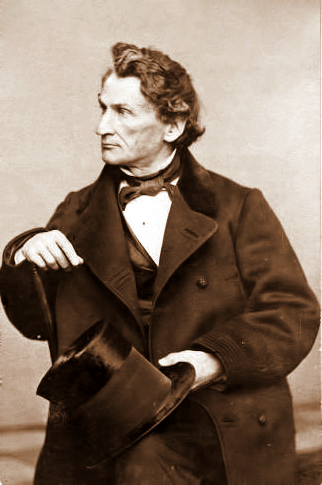
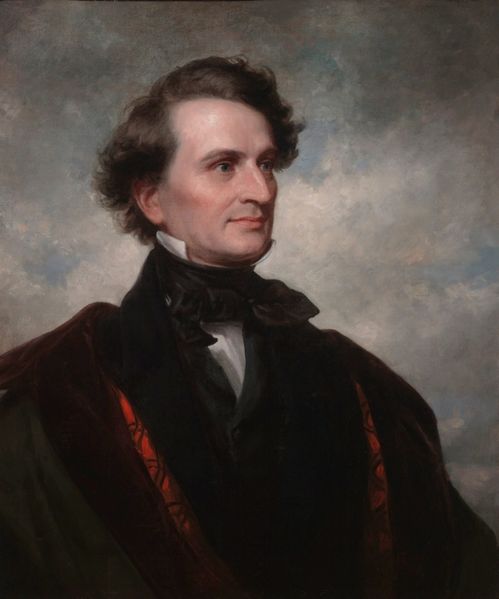
James Dwight Dana (1813 – 1895) was an American geologist, mineralogist, volcanologist and zoologist. He made pioneering studies of mountain - building, volcanic activity and the origin and structure of continents and oceans around the world.
Dana was born February 12, 1813 in Utica, New York. His father was merchant James Dana (1780 – 1860), and mother was Harriet Dwight (1792 – 1870). Through his mother he was related to the Dwight New England family of missionaries and educators including uncle Harrison Gray Otis Dwight and first cousin Henry Otis Dwight. He showed an early interest in science, which had been fostered by Fay Edgerton, a teacher in the Utica high school, and in 1830 he entered Yale College in order to study under Benjamin Silliman the elder. Graduating in 1833, for the next two years he was teacher of mathematics to midshipmen in the Navy, and sailed to the Mediterranean while engaged in his duties.
In 1836 and 1837 he was assistant to Professor Silliman in the chemical laboratory at Yale, and then, for four years, acted as mineralogist and geologist of the United States Exploring Expedition, commanded by Captain Charles Wilkes, in the Pacific Ocean. His labors in preparing the reports of his explorations occupied parts of thirteen years after his return to America in 1842. His notebooks from the four years of travel contained fifty sketches, maps and diagrams, including views of both Mount Shasta and Castle Crags. Dana's sketch of Mount Shasta was engraved in 1849 for publication in the American Journal of Science and Arts (which Silliman had founded in 1818), along with a lengthy article based on Dana's 1841 geological notes. In the article he described in scientific terms the rocks, minerals and geology of the Shasta region. As far as is known, his sketch of Mount Shasta became the second view of the mountain ever published.
In 1844 he again became a resident of New Haven, and married Professor Silliman's daughter, Henrietta Frances Silliman. In 1850, he was appointed as Silliman's successor, as Silliman Professor of Natural History and Geology in Yale College, a position which he held until 1892. In 1846 he became joint editor, and during the later years of his life was chief editor, of the American Journal of Science and Arts, to which he was a constant contributor, principally of articles on geology and mineralogy.
The 1849 publication of his geology of Mount Shasta was undoubtedly a response to the California gold rush publicity. Dana was the pre - eminent U.S. geologist of his time, and he also was one of the few trained observers anywhere who had first hand knowledge of the northern California terrain. He had previously written that there was likelihood that gold was to be found all along the route between the Umpqua River in Oregon and the Sacramento Valley. He was probably deluged with inquiries about the Shasta region, and was forced to publish in more detail some advice to the would - be gold miners.
Dana was responsible for developing much of the early knowledge on Hawaiian volcanism. In 1880 and 1881 he led the first geological study of the volcanics of Hawaii island. Dana theorized that the volcanic chain consisted of two volcanic strands, dubbed the "Loa" and "Kea" trends. The Kea trend included Kīlauea, Mauna Kea, Kohala, Haleakala, and West Maui. The Loa trend includes Lōʻihi, Mauna Loa, Hualālai, Kahoʻolawe, Lānaʻi, and West Molokaʻi.
Following another expedition by fellow geologist C.E. Dutton in 1884, Dana returned to the island once again and in 1890 he published a manuscript on the island that was the most detailed of its day, and would be the definite source upon the island's volcanics for decades.
Dana died on April 14, 1895. His son, Edward Salisbury Dana (1849 – 1935) was also a distinguished mineralogist.
Dana's best known books were his System of Mineralogy (1837), his Manual of Mineralogy (1848) and his Manual of Geology (1863). A bibliographical list of his writings shows 214 titles of books and papers, beginning in 1835 with a paper on the conditions of Vesuvius in 1834. His reports on Zoophytes, on the Geology of the Pacific Area, and on Crustacea, summarizing his work on the Wilkes Expedition, appeared from 1846 onward. Other works included Manual of Mineralogy (1848), afterwards entitled Manual of Mineralogy and Lithology (ed. 4, 1887); and Corals and Coral Islands (1872; revised ed. 1890). In 1887, Dana revisited the Hawaiian Islands, and the results of his further investigations were published in a quarto volume entitled Characteristics of Volcanoes (1890).
The Manual of Mineralogy by J.D. Dana became a standard college text, and has been continuously revised and updated by a succession of editors including W.E. Ford (13th - 14th eds., 1912 – 1929), Cornelius S. Hurlbut (15th - 21st eds., 1941 – 1999), and beginning with the 22nd by Cornelis Klein. The 23rd edition was in print under the title Manual of Mineral Science (Manual of Mineralogy) (2007), revised by Cornelis Klein and Barbara Dutrow.
Dana's System of Mineralogy has also been revised, the 6th edition (1892) being edited by his son Edward Salisbury Dana. A 7th edition was published in 1944, and the 8th edition was published in 1997 under the title Dana's New Mineralogy, edited by R.V. Gaines et al.
Dana published a number of manuscripts in an effort to reconcile scientific findings with the Bible between 1856 and 1857 and which are called Science and the Bible.
Dana was awarded the Copley Medal by the Royal Society in 1877, the Wollaston Medal by the Geological Society of London in 1874 and the Clarke Medal by the Royal Society of New South Wales in 1882.
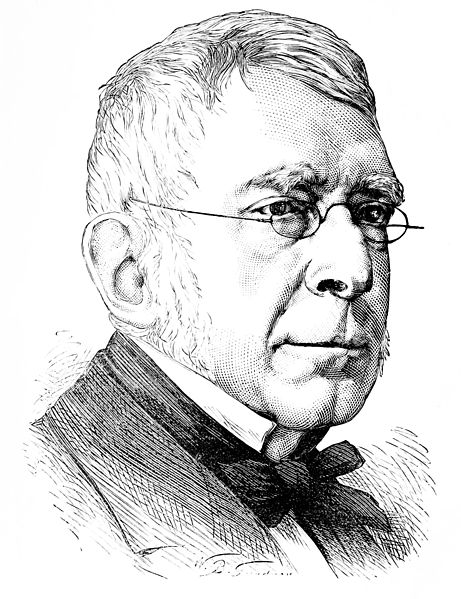
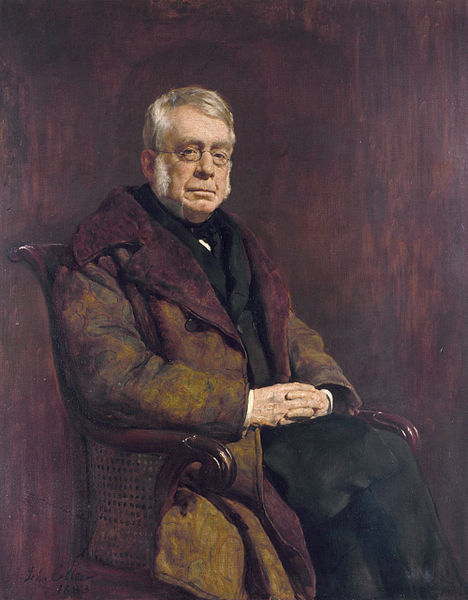
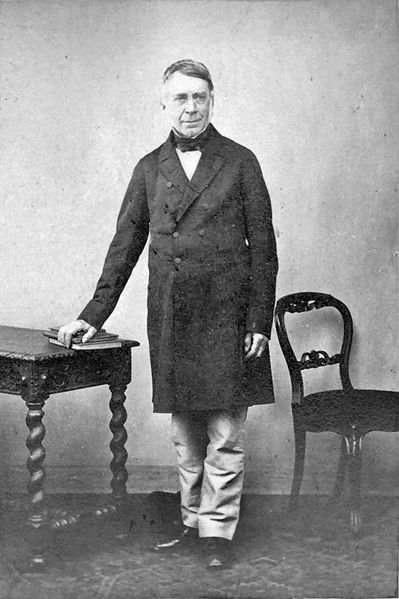
Sir George Biddell Airy PRS KCB (27 July 1801 – 2 January 1892) was an English mathematician and astronomer, Astronomer Royal from 1835 to 1881. His many achievements include work on planetary orbits, measuring the mean density of the Earth, a method of solution of two - dimensional problems in solid mechanics and, in his role as Astronomer Royal, establishing Greenwich as the location of the prime meridian. His reputation has been tarnished by allegations that, through his inaction, Britain lost the opportunity of priority in the discovery of Neptune.
Airy was born at Alnwick, one of a long line of Airys who traced their descent back to a family of the same name residing at Kentmere, in Westmorland, in the 14th century. The branch to which he belonged, having suffered in the English Civil War, moved to Lincolnshire and became farmers. Airy was educated first at elementary schools in Hereford, and afterwards at Colchester Royal Grammar School. An introverted child, Airy gained popularity with his schoolmates through his great skill in the construction of peashooters.
From the age of 13, Airy stayed frequently with his uncle, Arthur Biddell at Playford, Suffolk. Biddell introduced Airy to his friend Thomas Clarkson, the slave trade abolitionist who lived at Playford Hall. Clarkson had an MA in mathematics from Cambridge, and examined Airy in classics and then subsequently arranged for him to be examined by a Fellow from Trinity College, Cambridge, on his knowledge of mathematics. As a result he entered Trinity in 1819, as a sizar, meaning that he paid a reduced fee but essentially worked as a servant to make good the fee reduction. Here he had a brilliant career, and seems to have been almost immediately recognized as the leading man of his year. In 1822 he was elected scholar of Trinity, and in the following year he graduated as senior wrangler and obtained first Smith's prize. On 1 October 1824 he was elected fellow of Trinity, and in December 1826 was appointed Lucasian professor of mathematics in succession to Thomas Turton. This chair he held for little more than a year, being elected in February 1828 Plumian professor of astronomy and director of the new Cambridge Observatory. In 1836 he was elected a Fellow of the Royal Society and in 1840, a foreign member of the Royal Swedish Academy of Sciences.
Some idea of his activity as a writer on mathematical and physical subjects during these early years may be gathered from the fact that previous to this appointment he had contributed no less than three important memoirs to the Philosophical Transactions of the Royal Society, and eight to the Cambridge Philosophical Society. At the Cambridge observatory Airy soon showed his power of organization. The only telescope in the establishment when he took charge was the transit instrument, and to this he vigorously devoted himself. By the adoption of a regular system of work, and a careful plan of reduction, he was able to keep his observations up to date, and published them annually with a punctuality which astonished his contemporaries. Before long a mural circle was installed, and regular observations were instituted with it in 1833. In the same year the Duke of Northumberland presented the Cambridge observatory with a fine object - glass of 12 inch aperture, which was mounted according to Airy's designs and under his superintendence, although construction was not completed until after he moved to Greenwich in 1835.
Airy's writings during this time are divided between mathematical physics and astronomy. The former are for the most part concerned with questions relating to the theory of light arising out of his professorial lectures, among which may be specially mentioned his paper On the Diffraction of an Object - Glass with Circular Aperture, and his enunciation of the complete theory of the rainbow. In 1831 the Copley Medal of the Royal Society was awarded to him for these researches. Of his astronomical writings during this period the most important are his investigation of the mass of Jupiter, his report to the British Association on the progress of astronomy during the 19th century, and his work On an Inequality of Long Period in the Motions of the Earth and Venus.
One of the sections of his able and instructive report was devoted to "A Comparison of the Progress of Astronomy in England with that in other Countries," very much to the disadvantage of England. This reproach was subsequently to a great extent removed by his own labors.
Airy's discovery of a new inequality in the motions of Venus and the Earth is in some respects his most remarkable achievement. In correcting the elements of Delambre's solar tables he had been led to suspect an inequality overlooked by their constructor. The cause of this he did not long seek in vain; thirteen times the mean motion of Venus is so nearly equal to eight times that of Earth that the difference amounts to only a small fraction of Earth's mean motion, and from the fact that the term depending on this difference, although very small in itself, receives in the integration of the differential equations a multiplier of about 2,200,000, Airy was led to infer the existence of a sensible inequality extending over 240 years (Phil. Trans. cxxii. 67). The investigation was probably the most laborious that had been made up to Airy's time in planetary theory, and represented the first specific improvement in the solar tables effected in England since the establishment of the theory of gravitation. In recognition of this work the Gold Medal of the Royal Astronomical Society was awarded to him in 1833 (he would win it again in 1846).
In June 1835 Airy was appointed Astronomer Royal in succession to John Pond, and began his long career at the national observatory which constitutes his chief title to fame. The condition of the observatory at the time of his appointment was such that Lord Auckland, the first Lord of the Admiralty, considered that "it ought to be cleared out," while Airy admitted that "it was in a queer state." With his usual energy he set to work at once to reorganize the whole management. He remodeled the volumes of observations, put the library on a proper footing, mounted the new (Sheepshanks) equatorial and organized a new magnetic observatory. In 1847 an altazimuth was erected, designed by Airy to enable observations of the moon to be made not only on the meridian, but whenever it might be visible. In 1848 Airy invented the reflex zenith tube to replace the zenith sector previously employed. At the end of 1850 the great transit circle of 203 mm (8 inch) aperture and 3.5 m (11 ft 6 in) focal length was erected, and is still the principal instrument of its class at the observatory. The mounting in 1859 of an equatorial of 330 mm (13 inch) aperture evoked the comment in his journal for that year, "There is not now a single person employed or instrument used in the observatory which was there in Mr Pond's time"; and the transformation was completed by the inauguration of spectroscopic work in 1868 and of the photographic registration of sunspots in 1873.
The formidable undertaking of reducing the accumulated planetary observations made at Greenwich from 1750 to 1830 was already in progress under Airy's supervision when he became Astronomer Royal. Shortly afterwards he undertook the further laborious task of reducing the enormous mass of observations of the moon made at Greenwich during the same period under the direction, successively, of James Bradley, Nathaniel Bliss, Nevil Maskelyne and John Pond, to defray the expense of which a large sum of money was allotted by the Treasury. As a result, no less than 8,000 lunar observations were rescued from oblivion, and were, in 1846, placed at the disposal of astronomers in such a form that they could be used directly for comparison with the theory and for the improvement of the tables of the moon's motion.
For this work Airy received in 1848 a testimonial from the Royal Astronomical Society, and it at once led to the discovery by Peter Andreas Hansen of two new inequalities in the moon's motion. After completing these reductions, Airy made inquiries, before engaging in any theoretical investigation in connection with them, whether any other mathematician was pursuing the subject, and learning that Hansen had taken it in hand under the patronage of the king of Denmark, but that, owing to the death of the king and the consequent lack of funds, there was danger of his being compelled to abandon it, he applied to the admiralty on Hansen's behalf for the necessary sum. His request was immediately granted, and thus it came about that Hansen's famous Tables de la Lune were dedicated to La Haute Amirauté de sa Majesté la Reine de la Grande Bretagne et d'Irlande.
In 1851 Airy established a new Prime Meridian at Greenwich. This line, the fourth "Greenwich Meridian," became the definitive internationally recognized line in 1884.
In June 1846, Airy started corresponding with French astronomer Urbain Le Verrier over the latter's prediction that irregularities in the motion of Uranus were due to a so-far unobserved body. Aware that Cambridge Astronomer John Couch Adams had suggested that he had made similar predictions, on 9 July Airy entreated James Challis to undertake a systematic search in the hope of securing the triumph of discovery for Britain. Ultimately, a rival search in Berlin by Johann Gottfried Galle, instigated by Le Verrier, won the race for priority. Though Airy was "abused most savagely both by English and French" for his failure to act on Adams's suggestions more promptly, there have also been claims that Adams's communications had been vague and dilatory and further that the search for a new planet was not the responsibility of the Astronomer Royal.
One of the most remarkable of Airy's researches was his determination of the mean density of the Earth. In 1826, the idea occurred to him of attacking this problem by means of pendulum experiments at the top and bottom of a deep mine. His first attempt, made in the same year, at the Dolcoath mine in Cornwall, failed in consequence of an accident to one of the pendulums. A second attempt in 1828 was defeated by a flooding of the mine, and many years elapsed before another opportunity presented itself. The experiments eventually took place at the Harton pit near South Shields in 1854. Their immediate result was to show that gravity at the bottom of the mine exceeded that at the top by 1/19286 of its amount, the depth being 383 m (1,256 ft) From this he was led to the final value of Earth's specific density of 6.566. This value, although considerably in excess of that previously found by different methods, was held by Airy, from the care and completeness with which the observations were carried out and discussed, to be "entitled to compete with the others on, at least, equal terms." (The currently accepted value for Earth's density is 5.5153 g/cm³.)
By means of a water filled telescope, Airy in 1871 looked for a change in stellar aberration through the refracting water due to an ether drag. Like in all other aether drift experiments, he obtained a negative result.
In 1872 Airy conceived the idea of treating the lunar theory in a new way, and at the age of seventy - one he embarked on the prodigious toil which this scheme entailed. A general description of his method will be found in the Monthly Notices of the Royal Astronomical Society, vol. xxxiv, No. 3. It consisted essentially in the adoption of Charles - Eugène Delaunay's final numerical expressions for longitude, latitude and parallax, with a symbolic term attached to each number, the value of which was to be determined by substitution in the equations of motion.
In this mode of treating the question the order of the terms is numerical, and though the amount of labor is such as might well have deterred a younger man, yet the details were easy, and a great part of it might be entrusted to "a mere computer". (Note that at the time that this was written, the term "computer" referred to a human being who performed calculating work, either manually or with mechanical aids).
The work was published in 1886, when its author was eighty - five years of age. For some little time previously he had been harassed by a suspicion that certain errors had crept into the computations, and accordingly he addressed himself to the task of revision. But his powers were no longer what they had been, and he was never able to examine sufficiently into the matter. In 1890 he tells us how a grievous error had been committed in one of the first steps, and pathetically adds, "My spirit in the work was broken, and I have never heartily proceeded with it since."
In 1862, Airy presented a new technique to determine the strain and stress field within a beam. This technique, sometimes called the Airy stress function method, can be used to find solutions to many two - dimensional problems in solid mechanics. For example, it was used by H.M. Westergaard to determine the stress and strain field around a crack tip and thereby this method contributed to the development of fracture mechanics.
Airy was consulted about wind speeds and pressures likely to be encountered on the proposed Forth suspension bridge being designed by Thomas Bouch for the North British Railway in the late 1870s. He thought that pressures no greater than about 10 pounds per square foot could be expected, a comment Bouch took to mean also applied to the first Tay railway bridge then being built. Much greater pressures however, can be expected in severe storms. Airy was called to give evidence before the Official Inquiry into the Tay Bridge disaster, and was criticized for his advice. However, little was known about the problems of wind resistance of large structures, and a Royal Commission on Wind Pressure was asked to conduct research into the problem.
In July 1824, Airy met Richarda Smith (1804 – 1875), "a great beauty", on a walking tour of Derbyshire. He later wrote, "Our eyes met ... and my fate was sealed ... I felt irresistibly that we must be united," and Airy proposed two days later. Richarda's father, the Revd Richard Smith, felt that Airy lacked the financial resources to marry his daughter. Only in 1830, with Airy established in his Cambridge position, was permission for the marriage granted.
The Airys had nine children, the eldest three dying in childhood. The eldest survivor, Wilfrid Airy, was the designer and engineer for "Colonel" George Tomline's Orwell Park observatory. Wilfrid's daughter was the artist Anna Airy.
Their eldest daughter, Hilda (1840 – 1916), married Edward Routh in 1864. Airy was knighted on 17 June 1872.
Airy retired in 1881, living with his two married daughters at Croom's Hill near Greenwich. In 1891, he suffered a fall and an internal injury. He survived the consequential surgery only a few days. His wealth at death was £27,713. Airy and his wife and three predeceased children are buried at St. Mary's Church in Playford, Suffolk. A cottage owned by Airy still stands, adjacent to the church and now in private hands.